Clinical Reasoning Assignment: Post-operative Nausea and Vomiting
VerifiedAdded on 2021/04/21
|10
|2549
|95
Report
AI Summary
This clinical reasoning assignment focuses on a patient, Darren, diagnosed with cholecystitis and undergoing a laparoscopic cholecystectomy. The assignment highlights the importance of addressing post-operative nausea and vomiting (PONV), a common side effect of anesthesia and opioid medications. It identifies PONV as a significant risk factor, especially given Darren's pre-existing condition. The report establishes a patient-centered SMART goal to prevent PONV in the first four hours post-operatively, outlining three key nursing interventions: hydration, administration of antiemetic drugs (propofol with dexamethasone), and patient education. The assignment details the assessment process, emphasizing the evaluation of the effectiveness of interventions, including hydration and medication effects, and the assessment of pain and distress. The report references several research articles to support the chosen interventions, emphasizing the importance of evidence-based practice in nursing care.
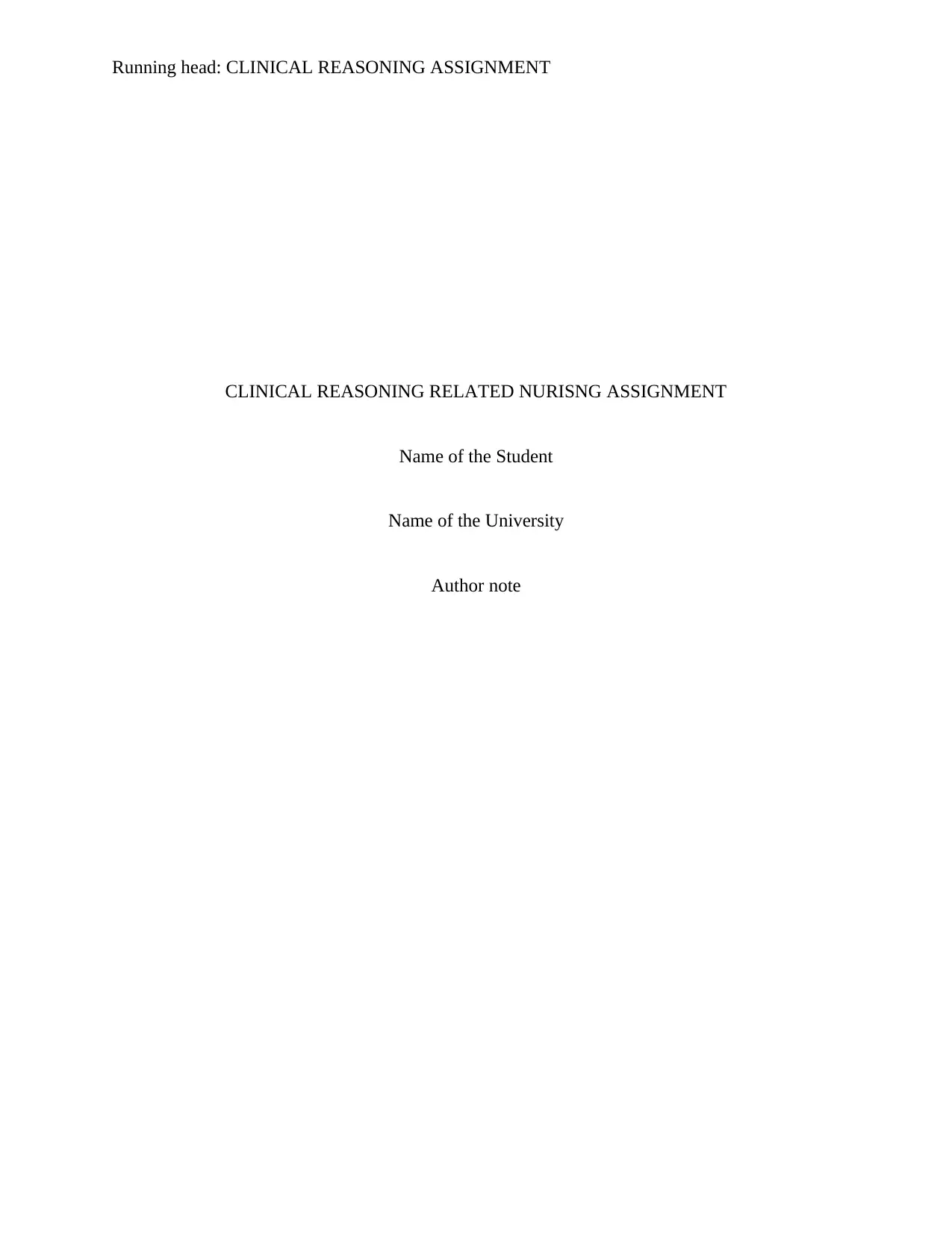
Running head: CLINICAL REASONING ASSIGNMENT
CLINICAL REASONING RELATED NURISNG ASSIGNMENT
Name of the Student
Name of the University
Author note
CLINICAL REASONING RELATED NURISNG ASSIGNMENT
Name of the Student
Name of the University
Author note
Paraphrase This Document
Need a fresh take? Get an instant paraphrase of this document with our AI Paraphraser
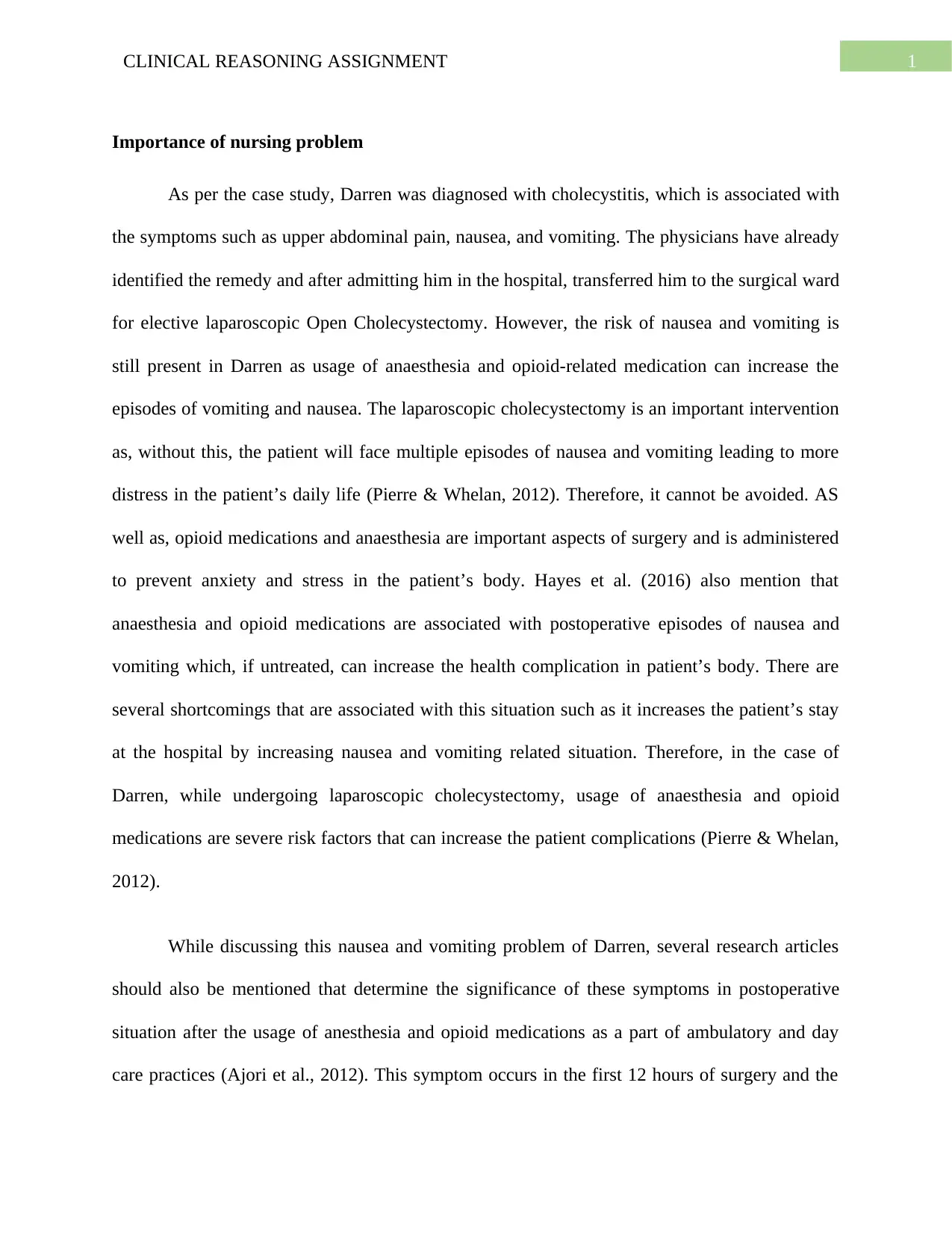
1CLINICAL REASONING ASSIGNMENT
Importance of nursing problem
As per the case study, Darren was diagnosed with cholecystitis, which is associated with
the symptoms such as upper abdominal pain, nausea, and vomiting. The physicians have already
identified the remedy and after admitting him in the hospital, transferred him to the surgical ward
for elective laparoscopic Open Cholecystectomy. However, the risk of nausea and vomiting is
still present in Darren as usage of anaesthesia and opioid-related medication can increase the
episodes of vomiting and nausea. The laparoscopic cholecystectomy is an important intervention
as, without this, the patient will face multiple episodes of nausea and vomiting leading to more
distress in the patient’s daily life (Pierre & Whelan, 2012). Therefore, it cannot be avoided. AS
well as, opioid medications and anaesthesia are important aspects of surgery and is administered
to prevent anxiety and stress in the patient’s body. Hayes et al. (2016) also mention that
anaesthesia and opioid medications are associated with postoperative episodes of nausea and
vomiting which, if untreated, can increase the health complication in patient’s body. There are
several shortcomings that are associated with this situation such as it increases the patient’s stay
at the hospital by increasing nausea and vomiting related situation. Therefore, in the case of
Darren, while undergoing laparoscopic cholecystectomy, usage of anaesthesia and opioid
medications are severe risk factors that can increase the patient complications (Pierre & Whelan,
2012).
While discussing this nausea and vomiting problem of Darren, several research articles
should also be mentioned that determine the significance of these symptoms in postoperative
situation after the usage of anesthesia and opioid medications as a part of ambulatory and day
care practices (Ajori et al., 2012). This symptom occurs in the first 12 hours of surgery and the
Importance of nursing problem
As per the case study, Darren was diagnosed with cholecystitis, which is associated with
the symptoms such as upper abdominal pain, nausea, and vomiting. The physicians have already
identified the remedy and after admitting him in the hospital, transferred him to the surgical ward
for elective laparoscopic Open Cholecystectomy. However, the risk of nausea and vomiting is
still present in Darren as usage of anaesthesia and opioid-related medication can increase the
episodes of vomiting and nausea. The laparoscopic cholecystectomy is an important intervention
as, without this, the patient will face multiple episodes of nausea and vomiting leading to more
distress in the patient’s daily life (Pierre & Whelan, 2012). Therefore, it cannot be avoided. AS
well as, opioid medications and anaesthesia are important aspects of surgery and is administered
to prevent anxiety and stress in the patient’s body. Hayes et al. (2016) also mention that
anaesthesia and opioid medications are associated with postoperative episodes of nausea and
vomiting which, if untreated, can increase the health complication in patient’s body. There are
several shortcomings that are associated with this situation such as it increases the patient’s stay
at the hospital by increasing nausea and vomiting related situation. Therefore, in the case of
Darren, while undergoing laparoscopic cholecystectomy, usage of anaesthesia and opioid
medications are severe risk factors that can increase the patient complications (Pierre & Whelan,
2012).
While discussing this nausea and vomiting problem of Darren, several research articles
should also be mentioned that determine the significance of these symptoms in postoperative
situation after the usage of anesthesia and opioid medications as a part of ambulatory and day
care practices (Ajori et al., 2012). This symptom occurs in the first 12 hours of surgery and the
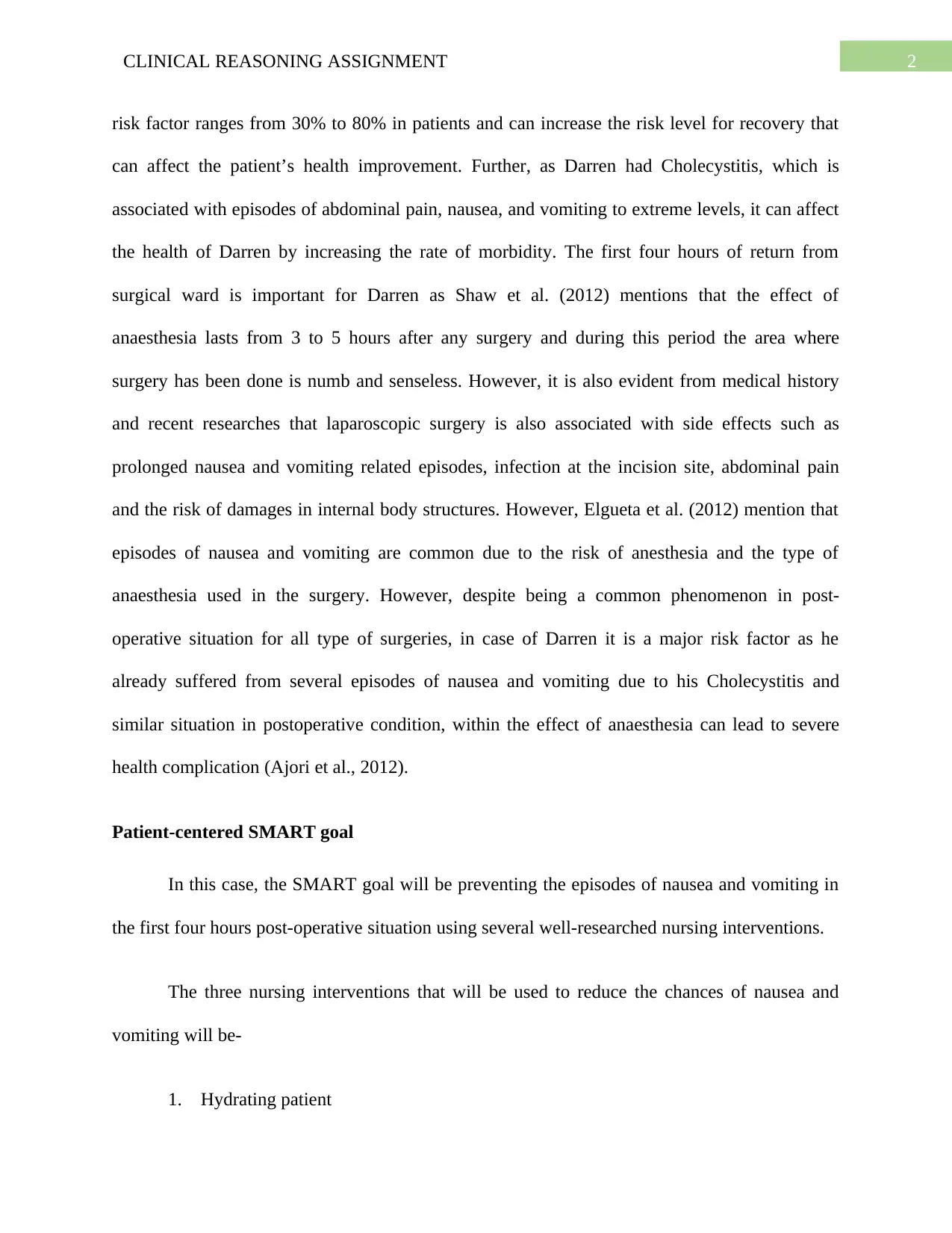
2CLINICAL REASONING ASSIGNMENT
risk factor ranges from 30% to 80% in patients and can increase the risk level for recovery that
can affect the patient’s health improvement. Further, as Darren had Cholecystitis, which is
associated with episodes of abdominal pain, nausea, and vomiting to extreme levels, it can affect
the health of Darren by increasing the rate of morbidity. The first four hours of return from
surgical ward is important for Darren as Shaw et al. (2012) mentions that the effect of
anaesthesia lasts from 3 to 5 hours after any surgery and during this period the area where
surgery has been done is numb and senseless. However, it is also evident from medical history
and recent researches that laparoscopic surgery is also associated with side effects such as
prolonged nausea and vomiting related episodes, infection at the incision site, abdominal pain
and the risk of damages in internal body structures. However, Elgueta et al. (2012) mention that
episodes of nausea and vomiting are common due to the risk of anesthesia and the type of
anaesthesia used in the surgery. However, despite being a common phenomenon in post-
operative situation for all type of surgeries, in case of Darren it is a major risk factor as he
already suffered from several episodes of nausea and vomiting due to his Cholecystitis and
similar situation in postoperative condition, within the effect of anaesthesia can lead to severe
health complication (Ajori et al., 2012).
Patient-centered SMART goal
In this case, the SMART goal will be preventing the episodes of nausea and vomiting in
the first four hours post-operative situation using several well-researched nursing interventions.
The three nursing interventions that will be used to reduce the chances of nausea and
vomiting will be-
1. Hydrating patient
risk factor ranges from 30% to 80% in patients and can increase the risk level for recovery that
can affect the patient’s health improvement. Further, as Darren had Cholecystitis, which is
associated with episodes of abdominal pain, nausea, and vomiting to extreme levels, it can affect
the health of Darren by increasing the rate of morbidity. The first four hours of return from
surgical ward is important for Darren as Shaw et al. (2012) mentions that the effect of
anaesthesia lasts from 3 to 5 hours after any surgery and during this period the area where
surgery has been done is numb and senseless. However, it is also evident from medical history
and recent researches that laparoscopic surgery is also associated with side effects such as
prolonged nausea and vomiting related episodes, infection at the incision site, abdominal pain
and the risk of damages in internal body structures. However, Elgueta et al. (2012) mention that
episodes of nausea and vomiting are common due to the risk of anesthesia and the type of
anaesthesia used in the surgery. However, despite being a common phenomenon in post-
operative situation for all type of surgeries, in case of Darren it is a major risk factor as he
already suffered from several episodes of nausea and vomiting due to his Cholecystitis and
similar situation in postoperative condition, within the effect of anaesthesia can lead to severe
health complication (Ajori et al., 2012).
Patient-centered SMART goal
In this case, the SMART goal will be preventing the episodes of nausea and vomiting in
the first four hours post-operative situation using several well-researched nursing interventions.
The three nursing interventions that will be used to reduce the chances of nausea and
vomiting will be-
1. Hydrating patient
⊘ This is a preview!⊘
Do you want full access?
Subscribe today to unlock all pages.

Trusted by 1+ million students worldwide
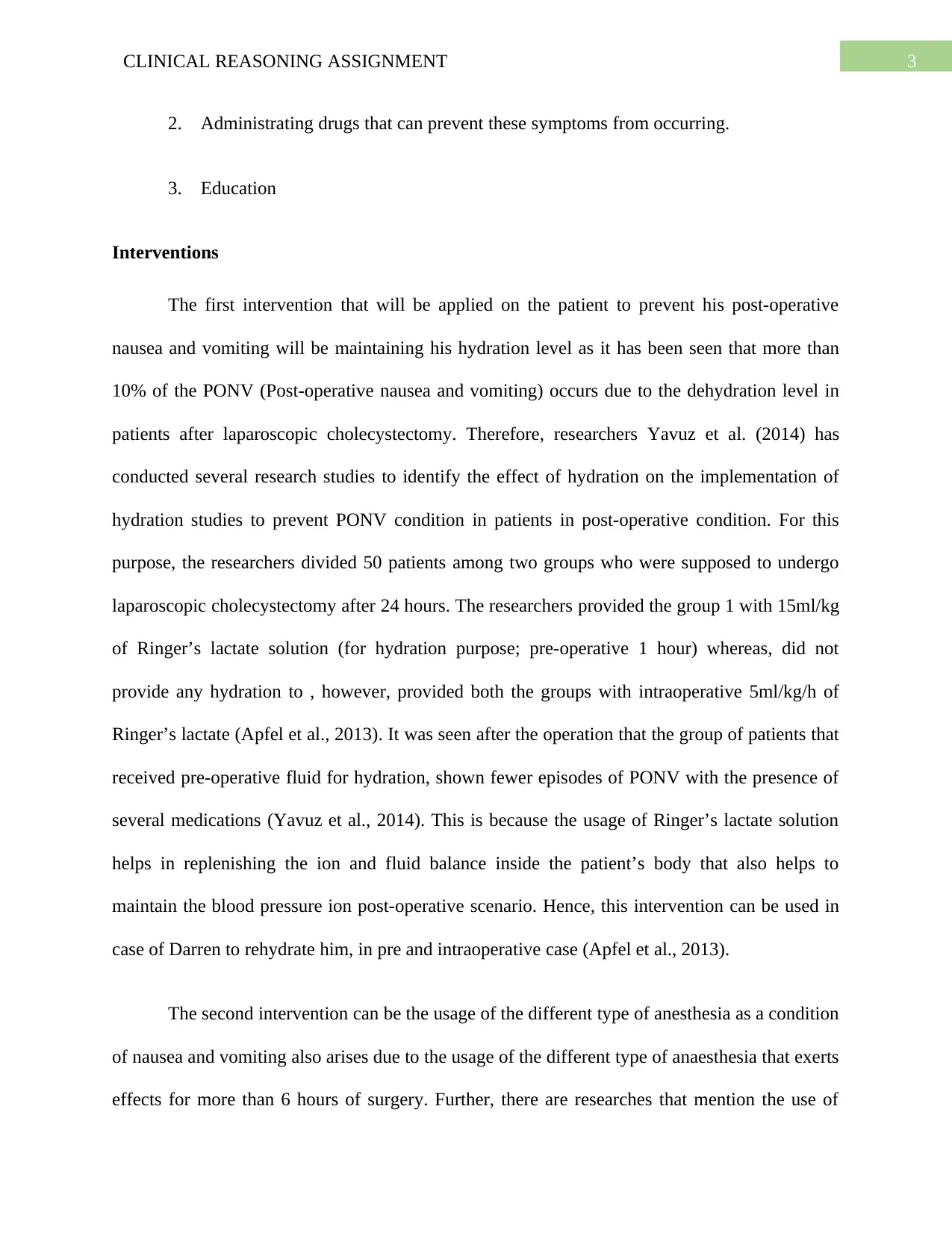
3CLINICAL REASONING ASSIGNMENT
2. Administrating drugs that can prevent these symptoms from occurring.
3. Education
Interventions
The first intervention that will be applied on the patient to prevent his post-operative
nausea and vomiting will be maintaining his hydration level as it has been seen that more than
10% of the PONV (Post-operative nausea and vomiting) occurs due to the dehydration level in
patients after laparoscopic cholecystectomy. Therefore, researchers Yavuz et al. (2014) has
conducted several research studies to identify the effect of hydration on the implementation of
hydration studies to prevent PONV condition in patients in post-operative condition. For this
purpose, the researchers divided 50 patients among two groups who were supposed to undergo
laparoscopic cholecystectomy after 24 hours. The researchers provided the group 1 with 15ml/kg
of Ringer’s lactate solution (for hydration purpose; pre-operative 1 hour) whereas, did not
provide any hydration to , however, provided both the groups with intraoperative 5ml/kg/h of
Ringer’s lactate (Apfel et al., 2013). It was seen after the operation that the group of patients that
received pre-operative fluid for hydration, shown fewer episodes of PONV with the presence of
several medications (Yavuz et al., 2014). This is because the usage of Ringer’s lactate solution
helps in replenishing the ion and fluid balance inside the patient’s body that also helps to
maintain the blood pressure ion post-operative scenario. Hence, this intervention can be used in
case of Darren to rehydrate him, in pre and intraoperative case (Apfel et al., 2013).
The second intervention can be the usage of the different type of anesthesia as a condition
of nausea and vomiting also arises due to the usage of the different type of anaesthesia that exerts
effects for more than 6 hours of surgery. Further, there are researches that mention the use of
2. Administrating drugs that can prevent these symptoms from occurring.
3. Education
Interventions
The first intervention that will be applied on the patient to prevent his post-operative
nausea and vomiting will be maintaining his hydration level as it has been seen that more than
10% of the PONV (Post-operative nausea and vomiting) occurs due to the dehydration level in
patients after laparoscopic cholecystectomy. Therefore, researchers Yavuz et al. (2014) has
conducted several research studies to identify the effect of hydration on the implementation of
hydration studies to prevent PONV condition in patients in post-operative condition. For this
purpose, the researchers divided 50 patients among two groups who were supposed to undergo
laparoscopic cholecystectomy after 24 hours. The researchers provided the group 1 with 15ml/kg
of Ringer’s lactate solution (for hydration purpose; pre-operative 1 hour) whereas, did not
provide any hydration to , however, provided both the groups with intraoperative 5ml/kg/h of
Ringer’s lactate (Apfel et al., 2013). It was seen after the operation that the group of patients that
received pre-operative fluid for hydration, shown fewer episodes of PONV with the presence of
several medications (Yavuz et al., 2014). This is because the usage of Ringer’s lactate solution
helps in replenishing the ion and fluid balance inside the patient’s body that also helps to
maintain the blood pressure ion post-operative scenario. Hence, this intervention can be used in
case of Darren to rehydrate him, in pre and intraoperative case (Apfel et al., 2013).
The second intervention can be the usage of the different type of anesthesia as a condition
of nausea and vomiting also arises due to the usage of the different type of anaesthesia that exerts
effects for more than 6 hours of surgery. Further, there are researches that mention the use of
Paraphrase This Document
Need a fresh take? Get an instant paraphrase of this document with our AI Paraphraser
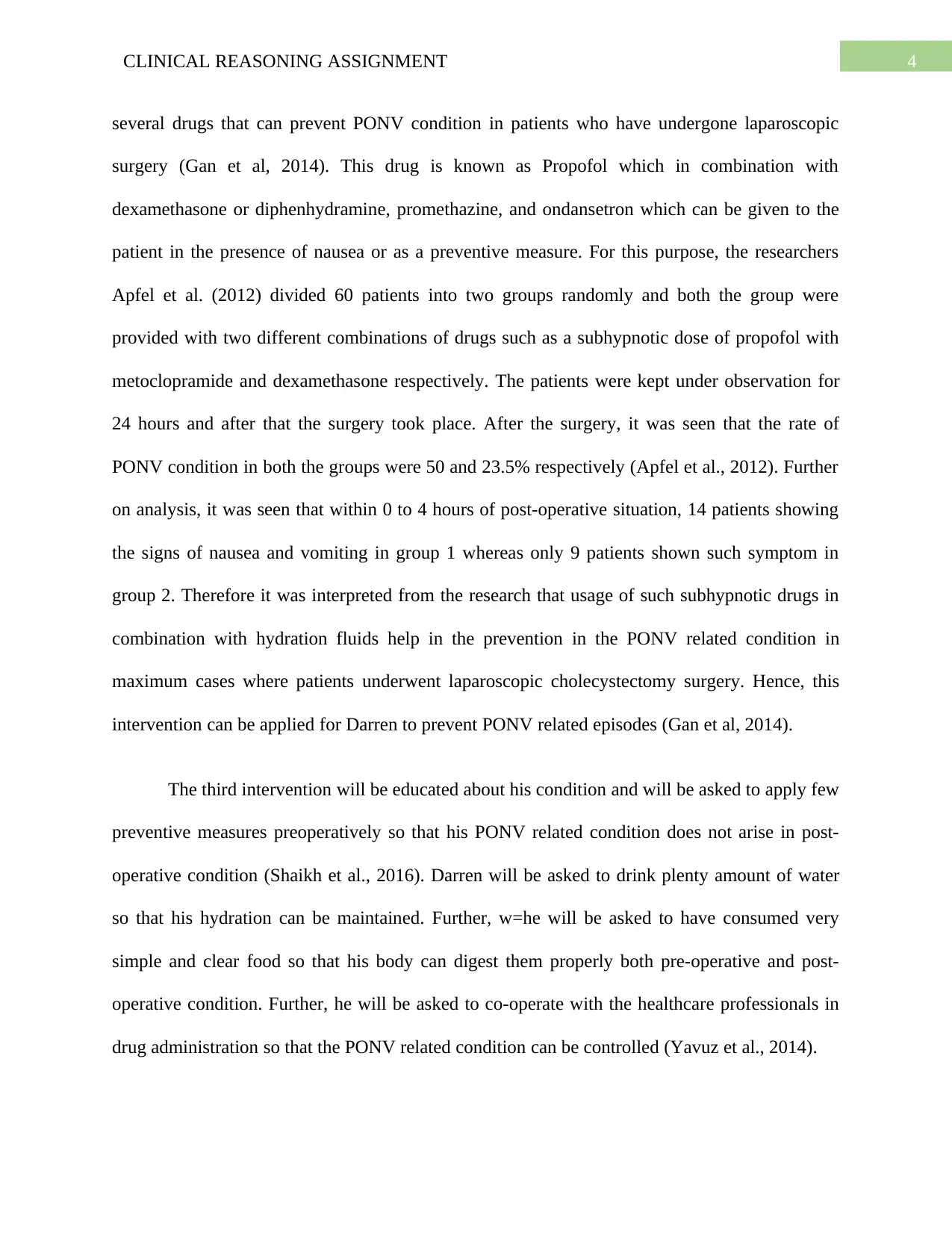
4CLINICAL REASONING ASSIGNMENT
several drugs that can prevent PONV condition in patients who have undergone laparoscopic
surgery (Gan et al, 2014). This drug is known as Propofol which in combination with
dexamethasone or diphenhydramine, promethazine, and ondansetron which can be given to the
patient in the presence of nausea or as a preventive measure. For this purpose, the researchers
Apfel et al. (2012) divided 60 patients into two groups randomly and both the group were
provided with two different combinations of drugs such as a subhypnotic dose of propofol with
metoclopramide and dexamethasone respectively. The patients were kept under observation for
24 hours and after that the surgery took place. After the surgery, it was seen that the rate of
PONV condition in both the groups were 50 and 23.5% respectively (Apfel et al., 2012). Further
on analysis, it was seen that within 0 to 4 hours of post-operative situation, 14 patients showing
the signs of nausea and vomiting in group 1 whereas only 9 patients shown such symptom in
group 2. Therefore it was interpreted from the research that usage of such subhypnotic drugs in
combination with hydration fluids help in the prevention in the PONV related condition in
maximum cases where patients underwent laparoscopic cholecystectomy surgery. Hence, this
intervention can be applied for Darren to prevent PONV related episodes (Gan et al, 2014).
The third intervention will be educated about his condition and will be asked to apply few
preventive measures preoperatively so that his PONV related condition does not arise in post-
operative condition (Shaikh et al., 2016). Darren will be asked to drink plenty amount of water
so that his hydration can be maintained. Further, w=he will be asked to have consumed very
simple and clear food so that his body can digest them properly both pre-operative and post-
operative condition. Further, he will be asked to co-operate with the healthcare professionals in
drug administration so that the PONV related condition can be controlled (Yavuz et al., 2014).
several drugs that can prevent PONV condition in patients who have undergone laparoscopic
surgery (Gan et al, 2014). This drug is known as Propofol which in combination with
dexamethasone or diphenhydramine, promethazine, and ondansetron which can be given to the
patient in the presence of nausea or as a preventive measure. For this purpose, the researchers
Apfel et al. (2012) divided 60 patients into two groups randomly and both the group were
provided with two different combinations of drugs such as a subhypnotic dose of propofol with
metoclopramide and dexamethasone respectively. The patients were kept under observation for
24 hours and after that the surgery took place. After the surgery, it was seen that the rate of
PONV condition in both the groups were 50 and 23.5% respectively (Apfel et al., 2012). Further
on analysis, it was seen that within 0 to 4 hours of post-operative situation, 14 patients showing
the signs of nausea and vomiting in group 1 whereas only 9 patients shown such symptom in
group 2. Therefore it was interpreted from the research that usage of such subhypnotic drugs in
combination with hydration fluids help in the prevention in the PONV related condition in
maximum cases where patients underwent laparoscopic cholecystectomy surgery. Hence, this
intervention can be applied for Darren to prevent PONV related episodes (Gan et al, 2014).
The third intervention will be educated about his condition and will be asked to apply few
preventive measures preoperatively so that his PONV related condition does not arise in post-
operative condition (Shaikh et al., 2016). Darren will be asked to drink plenty amount of water
so that his hydration can be maintained. Further, w=he will be asked to have consumed very
simple and clear food so that his body can digest them properly both pre-operative and post-
operative condition. Further, he will be asked to co-operate with the healthcare professionals in
drug administration so that the PONV related condition can be controlled (Yavuz et al., 2014).
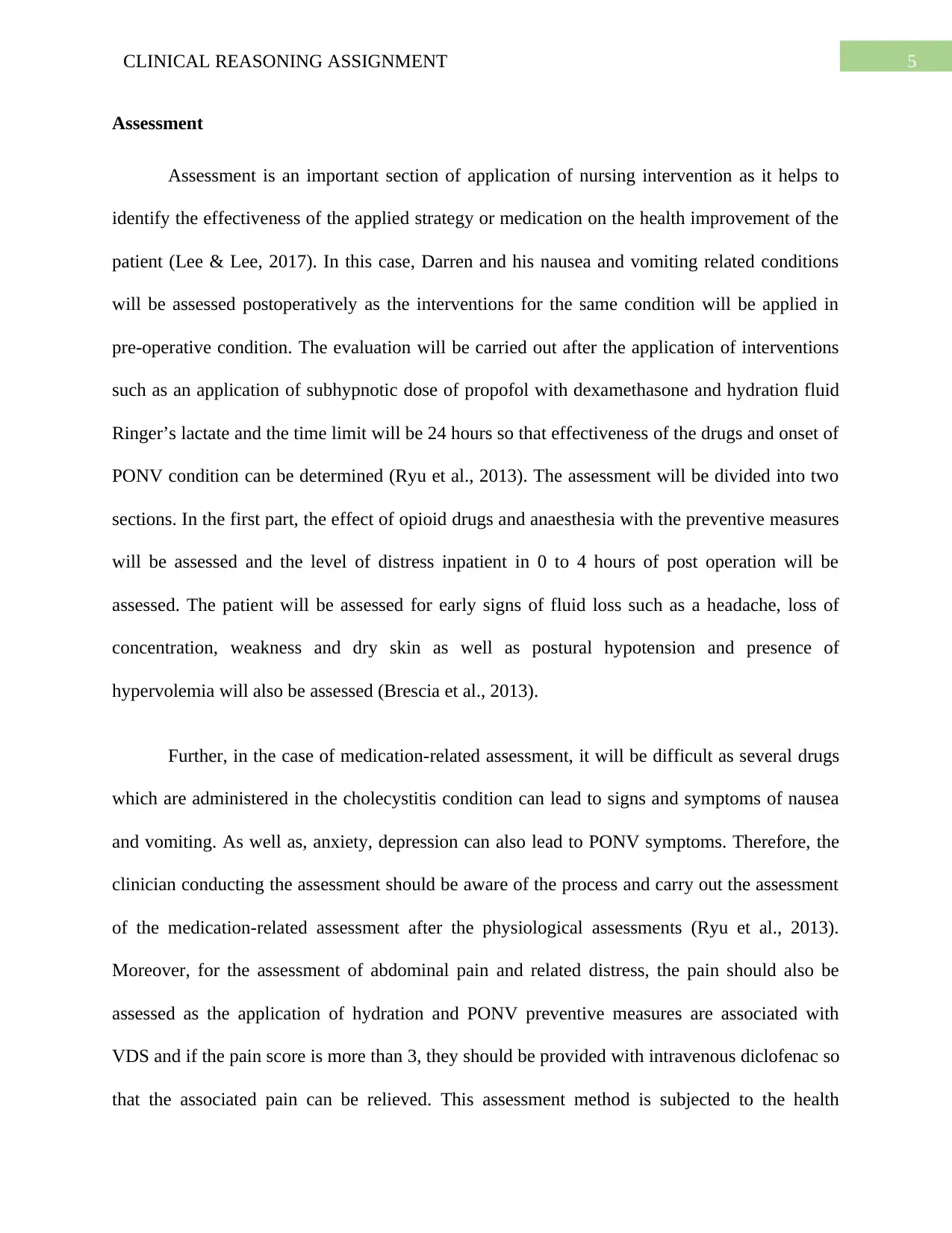
5CLINICAL REASONING ASSIGNMENT
Assessment
Assessment is an important section of application of nursing intervention as it helps to
identify the effectiveness of the applied strategy or medication on the health improvement of the
patient (Lee & Lee, 2017). In this case, Darren and his nausea and vomiting related conditions
will be assessed postoperatively as the interventions for the same condition will be applied in
pre-operative condition. The evaluation will be carried out after the application of interventions
such as an application of subhypnotic dose of propofol with dexamethasone and hydration fluid
Ringer’s lactate and the time limit will be 24 hours so that effectiveness of the drugs and onset of
PONV condition can be determined (Ryu et al., 2013). The assessment will be divided into two
sections. In the first part, the effect of opioid drugs and anaesthesia with the preventive measures
will be assessed and the level of distress inpatient in 0 to 4 hours of post operation will be
assessed. The patient will be assessed for early signs of fluid loss such as a headache, loss of
concentration, weakness and dry skin as well as postural hypotension and presence of
hypervolemia will also be assessed (Brescia et al., 2013).
Further, in the case of medication-related assessment, it will be difficult as several drugs
which are administered in the cholecystitis condition can lead to signs and symptoms of nausea
and vomiting. As well as, anxiety, depression can also lead to PONV symptoms. Therefore, the
clinician conducting the assessment should be aware of the process and carry out the assessment
of the medication-related assessment after the physiological assessments (Ryu et al., 2013).
Moreover, for the assessment of abdominal pain and related distress, the pain should also be
assessed as the application of hydration and PONV preventive measures are associated with
VDS and if the pain score is more than 3, they should be provided with intravenous diclofenac so
that the associated pain can be relieved. This assessment method is subjected to the health
Assessment
Assessment is an important section of application of nursing intervention as it helps to
identify the effectiveness of the applied strategy or medication on the health improvement of the
patient (Lee & Lee, 2017). In this case, Darren and his nausea and vomiting related conditions
will be assessed postoperatively as the interventions for the same condition will be applied in
pre-operative condition. The evaluation will be carried out after the application of interventions
such as an application of subhypnotic dose of propofol with dexamethasone and hydration fluid
Ringer’s lactate and the time limit will be 24 hours so that effectiveness of the drugs and onset of
PONV condition can be determined (Ryu et al., 2013). The assessment will be divided into two
sections. In the first part, the effect of opioid drugs and anaesthesia with the preventive measures
will be assessed and the level of distress inpatient in 0 to 4 hours of post operation will be
assessed. The patient will be assessed for early signs of fluid loss such as a headache, loss of
concentration, weakness and dry skin as well as postural hypotension and presence of
hypervolemia will also be assessed (Brescia et al., 2013).
Further, in the case of medication-related assessment, it will be difficult as several drugs
which are administered in the cholecystitis condition can lead to signs and symptoms of nausea
and vomiting. As well as, anxiety, depression can also lead to PONV symptoms. Therefore, the
clinician conducting the assessment should be aware of the process and carry out the assessment
of the medication-related assessment after the physiological assessments (Ryu et al., 2013).
Moreover, for the assessment of abdominal pain and related distress, the pain should also be
assessed as the application of hydration and PONV preventive measures are associated with
VDS and if the pain score is more than 3, they should be provided with intravenous diclofenac so
that the associated pain can be relieved. This assessment method is subjected to the health
⊘ This is a preview!⊘
Do you want full access?
Subscribe today to unlock all pages.

Trusted by 1+ million students worldwide
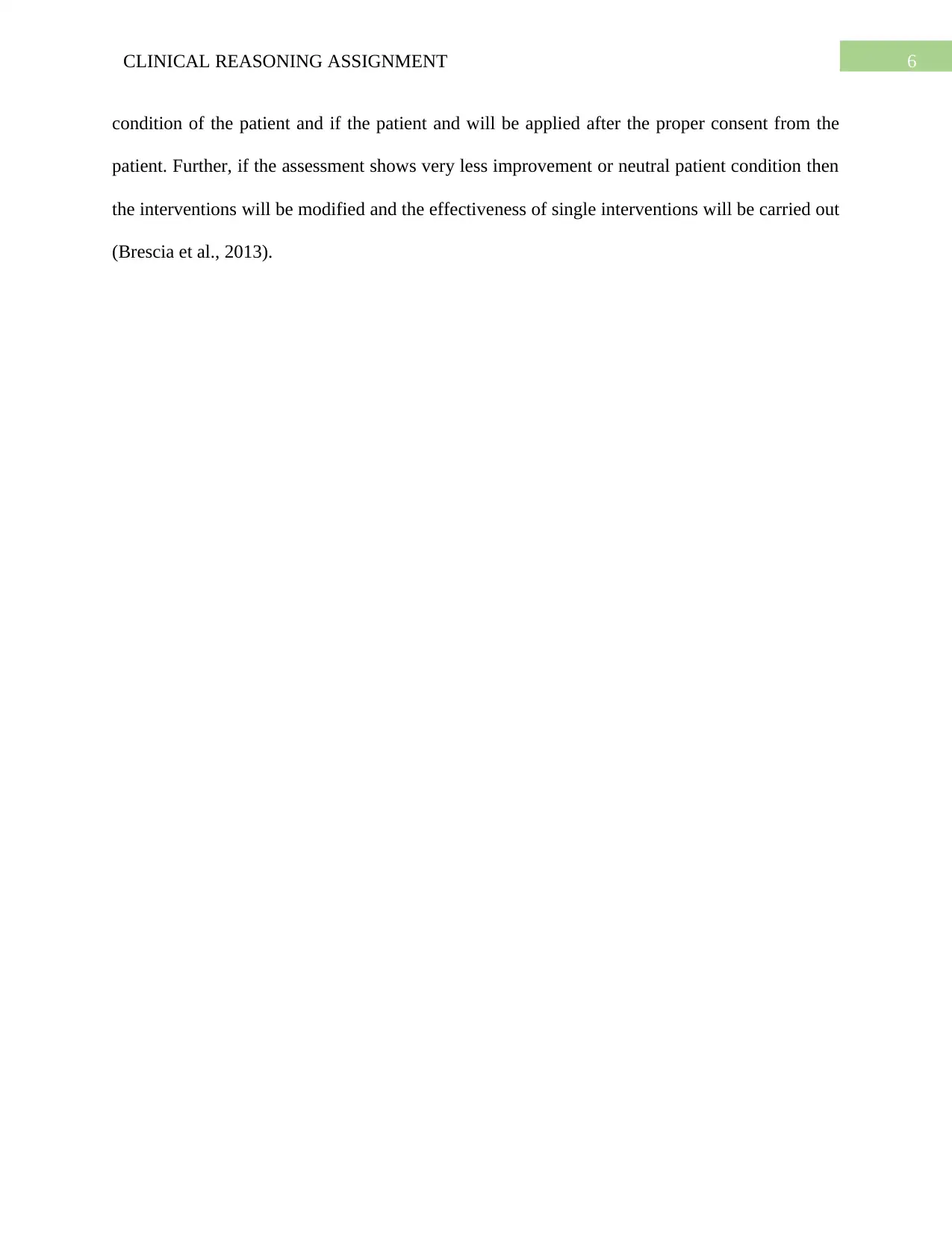
6CLINICAL REASONING ASSIGNMENT
condition of the patient and if the patient and will be applied after the proper consent from the
patient. Further, if the assessment shows very less improvement or neutral patient condition then
the interventions will be modified and the effectiveness of single interventions will be carried out
(Brescia et al., 2013).
condition of the patient and if the patient and will be applied after the proper consent from the
patient. Further, if the assessment shows very less improvement or neutral patient condition then
the interventions will be modified and the effectiveness of single interventions will be carried out
(Brescia et al., 2013).
Paraphrase This Document
Need a fresh take? Get an instant paraphrase of this document with our AI Paraphraser
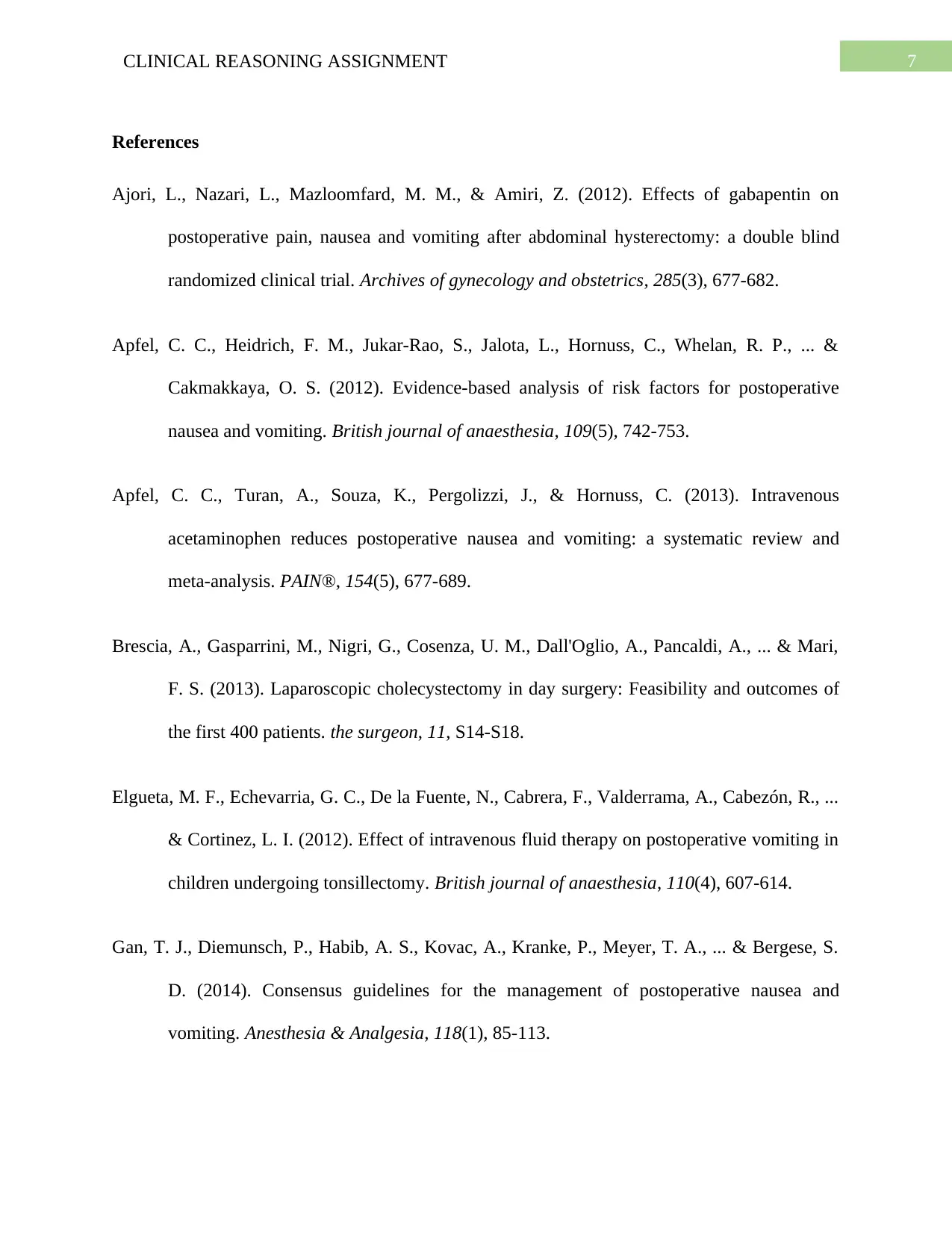
7CLINICAL REASONING ASSIGNMENT
References
Ajori, L., Nazari, L., Mazloomfard, M. M., & Amiri, Z. (2012). Effects of gabapentin on
postoperative pain, nausea and vomiting after abdominal hysterectomy: a double blind
randomized clinical trial. Archives of gynecology and obstetrics, 285(3), 677-682.
Apfel, C. C., Heidrich, F. M., Jukar-Rao, S., Jalota, L., Hornuss, C., Whelan, R. P., ... &
Cakmakkaya, O. S. (2012). Evidence-based analysis of risk factors for postoperative
nausea and vomiting. British journal of anaesthesia, 109(5), 742-753.
Apfel, C. C., Turan, A., Souza, K., Pergolizzi, J., & Hornuss, C. (2013). Intravenous
acetaminophen reduces postoperative nausea and vomiting: a systematic review and
meta-analysis. PAIN®, 154(5), 677-689.
Brescia, A., Gasparrini, M., Nigri, G., Cosenza, U. M., Dall'Oglio, A., Pancaldi, A., ... & Mari,
F. S. (2013). Laparoscopic cholecystectomy in day surgery: Feasibility and outcomes of
the first 400 patients. the surgeon, 11, S14-S18.
Elgueta, M. F., Echevarria, G. C., De la Fuente, N., Cabrera, F., Valderrama, A., Cabezón, R., ...
& Cortinez, L. I. (2012). Effect of intravenous fluid therapy on postoperative vomiting in
children undergoing tonsillectomy. British journal of anaesthesia, 110(4), 607-614.
Gan, T. J., Diemunsch, P., Habib, A. S., Kovac, A., Kranke, P., Meyer, T. A., ... & Bergese, S.
D. (2014). Consensus guidelines for the management of postoperative nausea and
vomiting. Anesthesia & Analgesia, 118(1), 85-113.
References
Ajori, L., Nazari, L., Mazloomfard, M. M., & Amiri, Z. (2012). Effects of gabapentin on
postoperative pain, nausea and vomiting after abdominal hysterectomy: a double blind
randomized clinical trial. Archives of gynecology and obstetrics, 285(3), 677-682.
Apfel, C. C., Heidrich, F. M., Jukar-Rao, S., Jalota, L., Hornuss, C., Whelan, R. P., ... &
Cakmakkaya, O. S. (2012). Evidence-based analysis of risk factors for postoperative
nausea and vomiting. British journal of anaesthesia, 109(5), 742-753.
Apfel, C. C., Turan, A., Souza, K., Pergolizzi, J., & Hornuss, C. (2013). Intravenous
acetaminophen reduces postoperative nausea and vomiting: a systematic review and
meta-analysis. PAIN®, 154(5), 677-689.
Brescia, A., Gasparrini, M., Nigri, G., Cosenza, U. M., Dall'Oglio, A., Pancaldi, A., ... & Mari,
F. S. (2013). Laparoscopic cholecystectomy in day surgery: Feasibility and outcomes of
the first 400 patients. the surgeon, 11, S14-S18.
Elgueta, M. F., Echevarria, G. C., De la Fuente, N., Cabrera, F., Valderrama, A., Cabezón, R., ...
& Cortinez, L. I. (2012). Effect of intravenous fluid therapy on postoperative vomiting in
children undergoing tonsillectomy. British journal of anaesthesia, 110(4), 607-614.
Gan, T. J., Diemunsch, P., Habib, A. S., Kovac, A., Kranke, P., Meyer, T. A., ... & Bergese, S.
D. (2014). Consensus guidelines for the management of postoperative nausea and
vomiting. Anesthesia & Analgesia, 118(1), 85-113.
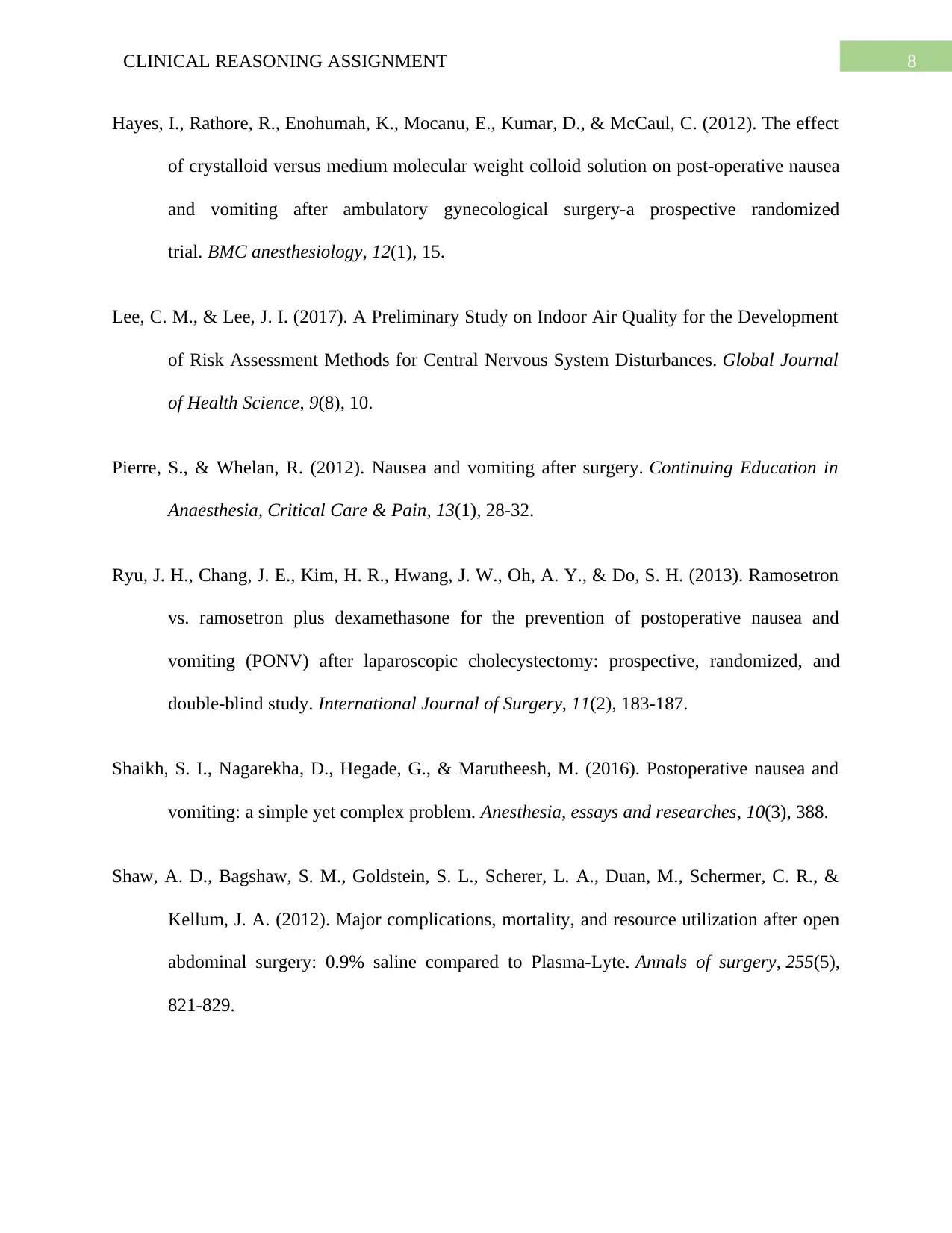
8CLINICAL REASONING ASSIGNMENT
Hayes, I., Rathore, R., Enohumah, K., Mocanu, E., Kumar, D., & McCaul, C. (2012). The effect
of crystalloid versus medium molecular weight colloid solution on post-operative nausea
and vomiting after ambulatory gynecological surgery-a prospective randomized
trial. BMC anesthesiology, 12(1), 15.
Lee, C. M., & Lee, J. I. (2017). A Preliminary Study on Indoor Air Quality for the Development
of Risk Assessment Methods for Central Nervous System Disturbances. Global Journal
of Health Science, 9(8), 10.
Pierre, S., & Whelan, R. (2012). Nausea and vomiting after surgery. Continuing Education in
Anaesthesia, Critical Care & Pain, 13(1), 28-32.
Ryu, J. H., Chang, J. E., Kim, H. R., Hwang, J. W., Oh, A. Y., & Do, S. H. (2013). Ramosetron
vs. ramosetron plus dexamethasone for the prevention of postoperative nausea and
vomiting (PONV) after laparoscopic cholecystectomy: prospective, randomized, and
double-blind study. International Journal of Surgery, 11(2), 183-187.
Shaikh, S. I., Nagarekha, D., Hegade, G., & Marutheesh, M. (2016). Postoperative nausea and
vomiting: a simple yet complex problem. Anesthesia, essays and researches, 10(3), 388.
Shaw, A. D., Bagshaw, S. M., Goldstein, S. L., Scherer, L. A., Duan, M., Schermer, C. R., &
Kellum, J. A. (2012). Major complications, mortality, and resource utilization after open
abdominal surgery: 0.9% saline compared to Plasma-Lyte. Annals of surgery, 255(5),
821-829.
Hayes, I., Rathore, R., Enohumah, K., Mocanu, E., Kumar, D., & McCaul, C. (2012). The effect
of crystalloid versus medium molecular weight colloid solution on post-operative nausea
and vomiting after ambulatory gynecological surgery-a prospective randomized
trial. BMC anesthesiology, 12(1), 15.
Lee, C. M., & Lee, J. I. (2017). A Preliminary Study on Indoor Air Quality for the Development
of Risk Assessment Methods for Central Nervous System Disturbances. Global Journal
of Health Science, 9(8), 10.
Pierre, S., & Whelan, R. (2012). Nausea and vomiting after surgery. Continuing Education in
Anaesthesia, Critical Care & Pain, 13(1), 28-32.
Ryu, J. H., Chang, J. E., Kim, H. R., Hwang, J. W., Oh, A. Y., & Do, S. H. (2013). Ramosetron
vs. ramosetron plus dexamethasone for the prevention of postoperative nausea and
vomiting (PONV) after laparoscopic cholecystectomy: prospective, randomized, and
double-blind study. International Journal of Surgery, 11(2), 183-187.
Shaikh, S. I., Nagarekha, D., Hegade, G., & Marutheesh, M. (2016). Postoperative nausea and
vomiting: a simple yet complex problem. Anesthesia, essays and researches, 10(3), 388.
Shaw, A. D., Bagshaw, S. M., Goldstein, S. L., Scherer, L. A., Duan, M., Schermer, C. R., &
Kellum, J. A. (2012). Major complications, mortality, and resource utilization after open
abdominal surgery: 0.9% saline compared to Plasma-Lyte. Annals of surgery, 255(5),
821-829.
⊘ This is a preview!⊘
Do you want full access?
Subscribe today to unlock all pages.

Trusted by 1+ million students worldwide
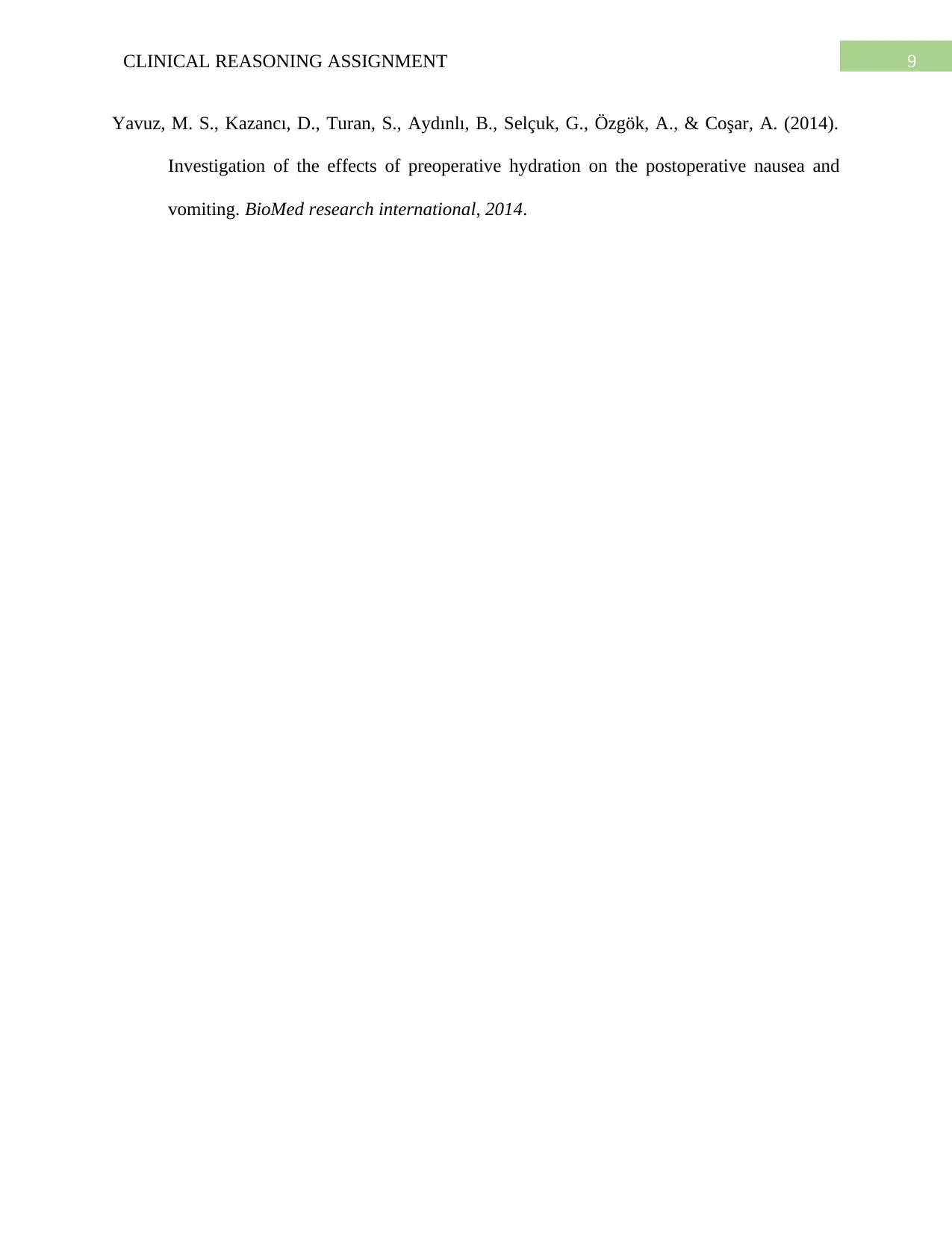
9CLINICAL REASONING ASSIGNMENT
Yavuz, M. S., Kazancı, D., Turan, S., Aydınlı, B., Selçuk, G., Özgök, A., & Coşar, A. (2014).
Investigation of the effects of preoperative hydration on the postoperative nausea and
vomiting. BioMed research international, 2014.
Yavuz, M. S., Kazancı, D., Turan, S., Aydınlı, B., Selçuk, G., Özgök, A., & Coşar, A. (2014).
Investigation of the effects of preoperative hydration on the postoperative nausea and
vomiting. BioMed research international, 2014.
1 out of 10
Related Documents
Your All-in-One AI-Powered Toolkit for Academic Success.
+13062052269
info@desklib.com
Available 24*7 on WhatsApp / Email
![[object Object]](/_next/static/media/star-bottom.7253800d.svg)
Unlock your academic potential
Copyright © 2020–2025 A2Z Services. All Rights Reserved. Developed and managed by ZUCOL.





